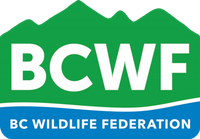Fishing and Hunting Update
by Wayne Zaccarelli
New Elk Lake Fishing Dock: A new metal fishing dock was recently installed on Elk Lake. The Victoria Golden Rods & Reels, a BCWF member club, led a successful fundraising drive, in collaboration with World Fisheries Trust and the Rotary Club of Saanich.
Funds for the dock were provided by the Capital Regional District ($125,000), Pacific Economic Development Agency of Canada ($109,000), Freshwater Fisheries Society of B.C. ($25,000) and the Rotary Club of Saanich ($1000).
The new dock replaces the original 1996 wooden structure. Jenkins Marine Ltd. manufactured and installed the dock. The design package and community support were important components in the application to PEDAC by World Fisheries Trust on behalf of the partner organizations.
Still to be installed is a hypolimnetic oxygenator which will increase the oxygen content of the deeper waters during the summer and early fall months. This will allow the lake to support increased trout production through greater available habitat. This will also reduce the occurrence of nuisance blue-green algal blooms.
Pinniped Predation on Salmonids: A Washington Department of Fish & Wildlife report, Pinniped Predation on Salmonids in the Washington Portions of the Salish Sea and Outer Coast, was released in November 2022. It concludes “The preponderance of evidence supports the hypothesis that current populations of pinnipeds [ie. seals and sea lions] are a contributing factor in the decline and depression of salmon populations.”
Eel Grass Surveys and Restoration: Nikki Wright of the Sea Change Marine Conservation Society gave an interesting talk on their work studying, surveying and restoring eel grass beds. The presentation at the BCWF Region 1 meeting held December 11 noted that eel grass is important as a substrate for herring spawn and provides protection and rearing habitat for juvenile salmonids and other small fish.
The Society was formed in 1998 and has transplanted eel grass at several sites on the south coast of B.C. They have had some success in the Cowichan River estuary but none at Tod Inlet near Brentwood. The eel grass propagates via nodes produced on the rhizome roots. Transplants are placed in water depths sufficiently deep to avoid Canada geese uprooting them.
AHD virus Killing Local Deer: Adenovirus Hemorrhagic Disease (AHD) has been identified as being responsible for killing Columbian Blacktail Deer on southern Vancouver Island. It has been found on some Gulf Islands (ie. Galiano, Mayne) and as far north as Parksville. It is highly contagious and lethal with no treatment. It is spread by direct contact with other deer. Symptoms include difficulty breathing, foaming or drooling at the mouth, diarrhea and seizures, ulcers and abscesses. Local Victoria municipalities have noticed an increased number of dead deer, which may be a direct result of the AHD virus.


